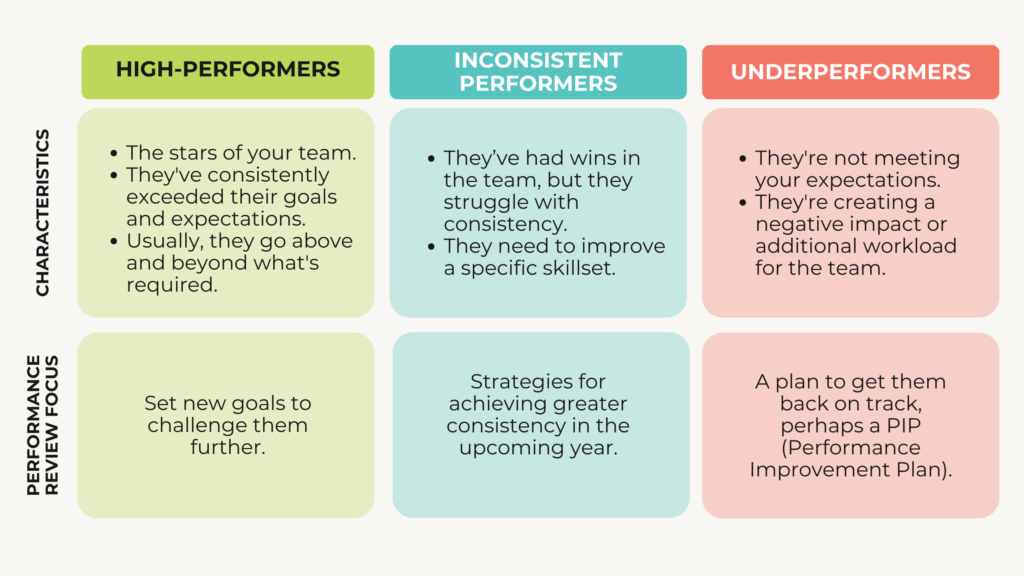How to Run an Effective Performance Review Conversation
Hi, I'm Mak. I'm a leadership coach for new managers who knows what it's like to be filled with overwhelm, self-doubt and terror that I’d let everyone down. My Story
FREE MICROCAST
How to Become an Effective Leader so You Can Build a High Performance Team
Learn how to delegate with confidence, navigate those tricky conversations (even for introverts!), and finally stop relying on Google to do your job.
Netflix < MakTV
THE YOUTUBE CHANNEL
No but really. This is the kinda content that’s actually healthy to binge. In fact, you become more of an awesomesauce manager with every video you watch.
As the end of the year approaches, you may be anticipating performance reviews with your team. But, if the thought of having these sitdowns with your team is keeping you up at night and making you feel anxious, you want to stick with me until the end because, in this blog post, I’m about to share with you a complete step-to-step guide to plan, conduct, and document your team’s yearly performance in an effective and productive way.
Here’s what we’ll cover in this blog post:
- What’s a performance review?
- The Performance Review Agenda
- The Bucket Strategy to a Productive Performance Review.
- How To Document Your Performance Review Conversations.
- FAQs About Effective Performance Reviews.
1. What is a Performance Review?
A performance review is nothing more than an annual work check-up, where you have a sit-down with each member of your team to chat about how they’re doing on the job. The main goal is to give feedback to your team about their work, highlight their wins, and identify the areas where they need to work in the upcoming year. It’s usually done at the end of the year – kind of like a year-end work summary – and gives your team members a clear picture of where they’re at in the company and their impact on the team’s goals and results.
The great thing about a performance review is that employees actually thrive on receiving feedback. In fact, according to a recent study from zippia.com, 65% of employees desire more feedback from their managers. Plus, these meetings aren’t just a pat on the back. They have many perks for you as a team leader, including:
- Promoting clear and open communication.
- Help motivate employees to perform better and excel at their roles.
- You have a clear picture to set up expectations, goals, and responsibilities for the upcoming year.
- Promoting a better work environment and team culture.
- You get to know each peer individually, their strengths and improvement areas. As well as their main contributions to the team.
What other benefits can you think of these Performance Review Meetings? Comment below!

2. The Performance Review Agenda.
Think of a Performance Review agenda as the GPS for your big chat with your team members. It’s a step-by-step guide that should include the following points:
- Introduction: Kick off the meeting with an agenda rundown; this way, you’ll let your team know what to expect and put their mind at ease. Another way to break the ice and ease the nerves is to ask your team members if they have any questions or concerns before diving in.
- Achievements: The next thing is to highlight this person’s big accomplishments throughout the year. It is the perfect way to boost their confidence and inspire them to keep up the great work.
- Goal Review: Zoom in on your expectations and goals and how each team member has or hasn’t accomplished them. A great way to track progress is to share KPIs so everyone can see how their hard work stacks up against the goals.
- Feedback and Improvement: This is perhaps the most important part of the meeting because it’s your chance to evaluate your team’s performance and improvements for the upcoming year. In this part of your meeting, you should assign an overall rating that reflects your team members’ review for the year. To keep things simple, I suggest using a rating scale that puts everyone in a lane, such as this one:
- 1: Does not meet expectations
- 2: Inconsistently meets expectations
- 3: Meets expectations
- 4: Exceeds expectations
You also want to ask your team to rate themselves a few weeks before the big review. It’s a great way to open up the conversation and hear their thoughts on their own performance.
- Career Development: Allow a few minutes in the meeting to discuss your peer’s future in the company and take note of the new skills they might need to learn to achieve that plan.
- Q&As: Give time to ask questions or address any concerns.
- Closing: To wrap things up, summarize everything you discussed and what comes next. Document the main points discussed and the next steps moving forward so you can touch base on future one-on-one meetings.
3. The Bucket Strategy to a Productive Performance Review.
One size doesn’t fit all when it comes to performance reviews. As I always like to mention to my NMA students, each team has diverse members with their own strengths and personalities; so, when approaching your team, you should follow the “Bucket Strategy” to a productive performance review, which is nothing other than dividing your team into categories:
- The High-Performers
- Inconsistent Performers, and
- Underperformers.
In the following graphic, you’ll see each peer’s characteristics listed so you can easily identify them in your team and what your focus should be during this one-on-one sitdown.

Can you see all three performers in your team? Comment below!
4. How To Document Your Performance Review Conversations.
After concluding your Performance Review Conversations with each team member, the next step is to keep track of everything you discussed and the plans for the future. This document will serve as a starting point for future follow-ups on the concrete actions and plans you’ve discussed during the meeting.
When documenting your performance reviews, make sure to:
- Share and communicate the report with each team member and HR. Ask them to raise a flag if they see any inconsistencies in the document so everyone is on the same page.
- Keep it objective without adding anything that could be easily misunderstood.
- Use the proper communication channels. For example, some companies use their inner cloud or system to maintain the document’s confidentiality.

5. FAQs About Effective Performance Reviews.
I know you may be having a lot of questions right now, so I’ve compiled the most frequently asked ones in this section:
#1. What is the one thing that makes a difference in Performance Reviews?
The game-changer in your performance review and your number one goal as a team leader should always be about helping each team member reach their full potential. Your focus should be on supporting and providing the resources they need to excel in the team.
#2. How far in advance should a manager provide the request for people to self-evaluate?
Most people need around two weeks to complete a self-evaluation. To plan effectively, I like to work backward from the review date. For example, if the Performance Review is scheduled for November 30th, you should provide the request on November 15th.
#3. What if your rating differs from the person’s self-rating?
If they rated themselves lower than you, ask your peers why they don’t think they’re at the same level as you’ve ranked them. It’s your job as the manager to explain why each team member is exceeding.
Now, if it’s the flip side, it’s a sign that you, as the manager, were not aligned, and somewhere along the year, you were not clear enough with the expectations or had the proper conversations to let them know they weren’t hitting the mark.
#4. What things should I consider in a Performance Improvement Plan?
If your peers need a Performance Improvement Plan, you should document this on the report you’ll be handling, making sure to address the following topics:
- Performance Issues: Identify the specific performance issues you brought up during the meeting, try to provide examples, and the impact these actions have on the team.
- Goals and expectations: You should document what the focus of this person should be for the upcoming year in a clear and concise way.
- Timeframe: State what the timeframe will be so that your peers can demonstrate improvement.
- Metrics: Try to include or set up checkpoints to help you track their progress and improvement.
- Resources and Support: State the resources, training, or support your team member may need to achieve the outlined goals. You can include additional training, mentorship, or access to specific tools or information.
- Regular Check-Ins: Monitor this person’s progress through regular check-ins and make any adjustments to the plan.
- Consequences and Next Steps: Lay out the consequences of not making progress towards your goals. Be transparent about what comes next if things don’t pick up, whether it is extra coaching, additional training, or even more serious repercussions.
#5. How do I evaluate one person’s performance if they have been on the team for less than a year?
Having a new peer in the team allows you to provide constructive feedback to support the employee’s ongoing development. Make sure to follow the previous points we addressed on the Performance Review Agenda, plus touch base on these additional ones:
- Learning Curve: Evaluate your team member’s learning curve and openness to take on new challenges and how quickly they’ve adapted to the team.
- Initiative: Mention to your peers if they have a go-getter attitude and have demonstrated initiative when it comes to tackling challenges.
- Improvement areas: Your new team members might still be finding their feet on the team, so be open to assessing their areas for growth and showing your support for working together to give clear feedback and track their progress towards nailing your expectations.
With so many details, make sure you don’t miss anything and check out the New Manager Accelerator, my signature coaching program to become the confident, competent, and inspiring leader you’re meant to be 🙂
Comment below if you have any other questions about how to conduct your Performance Review Meetings, and don’t forget to share this post with your friends and colleagues!

December 18, 2023